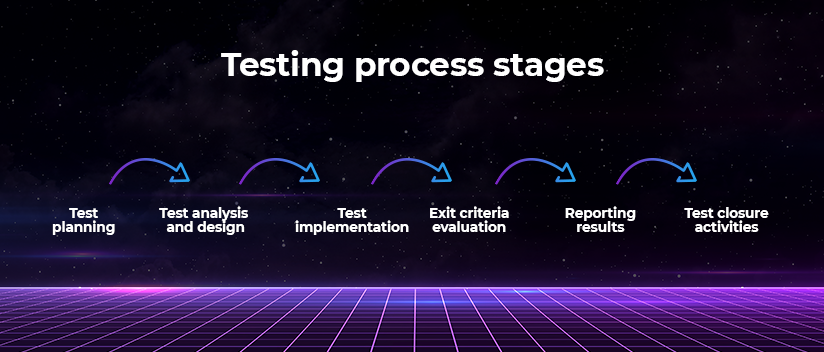In the global IT market, despite noticeable constraints, we still observe continuous growth of technological trends. The dynamic progress in areas such as artificial intelligence, mobile applications, or classic web applications requires constant adaptation of processes related to their development. This also applies to testing. When choosing a test type for a new project, readiness to face many challenges is crucial.
Effectively tailoring the testing process to the project’s characteristics increases the development team’s efficiency, contributes to resource optimization, and shortens time to market. Given the specifics and type of project, what aspects should a good testing process focus on? I aim to provide the answer in the following article.
What is software testing really about?
Everyone involved in software testing has heard this question at least once (and hopefully know the answer 😉). For others, I will briefly explain this matter.
The common stereotype about tests often reduces them to “clicking through the application” and reporting bugs when something doesn’t work. It’s partly true – during software testing, we aim to detect as many potential errors as possible. However, this process is much more complex, involving verifying if the software meets business requirements and user expectations. To achieve these goals, we use a testing process consisting of standardized stages.

It’s worth emphasizing that testing should begin as early as possible, ideally during the documentation phase.
The importance of matching test types to different project types
IT projects can be divided into many categories: mobile applications, web applications, desktop applications, embedded systems, cloud-based solutions, or microservice applications. Each category has its key operational aspects, so testers must apply the right test types to get the best results.
We have many options available. A comprehensive overview of each would require a separate article, that’s why I’ll provide a brief description here.
Functional tests – their main purpose is to verify the application’s adherence to requirements. These include, among others, unit tests, integration tests, system tests, and exploratory tests.
Non-functional tests – they include performance tests, stress/load tests, usability tests, security tests, and compatibility tests.
Structural tests – related to verifying the code, they aim to validate whether operations implemented in methods are executed correctly. They’re expressed as a percentage in relation to the coverage of a specific part of the code structure.
In addition, we also distinguish regression tests, smoke tests, and automated tests.
Web applications
Considering which tests should be conducted in the case of a web application, it’s worth asking about its specifics. Besides running classic functional, exploratory, or regression tests, we also need to know the answer to several important questions, such as: how does the application handle numerous simultaneous sessions, is it resistant to external attacks (due to its “exposure” on the network, especially if it stores important data, e.g., financial), and whether it’s intuitive and easy to use.
So, we already know that we need to conduct performance, security, and UI/usability tests. Another important issue is compatibility with required browsers, systems, or mobile devices. Having clear business requirements for all these aspects is vital, providing a solid foundation for our tests. We can also consider using automated tests, for example, for regression testing.
Mobile applications
Testing mobile applications shares many similarities with the above-described web application tests. Likewise, for web applications, due to the vast diversity of mobile devices and screen sizes, compatibility tests will be necessary. Additionally, we need to perform UI tests, performance tests (regarding battery usage), security tests, and usability tests. Since we are dealing with a mobile device, we must remember to test whether all aspects related to location change (such as time or GPS usage) work correctly.
In this case, we will also conduct functional, exploratory, smoke, and regression tests, and similarly to the above, we can rely on automation.
Desktop applications
When testing desktop applications, we will not only deal with different operating systems with which the solution must cooperate, but also with the major challenge – a vast diversity of hardware configurations. As a result, the compatibility tests required here will need to be more comprehensive. Another distinction from, for example, web applications is the necessity of conducting installation/uninstallation tests.
The other types of tests, such as functional, performance, security, UI/usability, and regression tests, remain unchanged.
Cloud applications
It’s important to remember that cloud applications operate within complex and dynamically changing environments, which requires a flexible approach to the testing process and implementing up-to-date tools. In contrast to the applications described above, verifying scalability (how the application responds to constantly changing resources) will be crucial in this case.
Among other new types of tests not previously discussed are data migration tests, such as from local applications to the cloud – their role is to verify whether migrated data is complete. Additionally, backup and application restoration tests will be helpful. Due to external exposure, similar to mobile applications, verifying security and resilience to external influences is critical.
Embedded systems
We face stringent hardware limitations and specific operational conditions when it comes to embedded systems. Their reliability is paramount since embedded systems are frequently integral to a device (e.g., game consoles), without which it won’t function. Hence, the functional tests will focus on interactions with hardware.
In this case, other types of tests necessary include performance tests, stress tests, integration tests, and standard – yet crucial – security tests.
Microservices applications
To conduct tests for a microservices-based application, we must first understand how it works.
When planning tests, we should consider the integration of cooperating components and multiple independent services. Therefore, an essential element of the process in this case must be planning and executing tests for both these components in isolation (unit tests) and their integration tests.
It’s also crucial to plan and implement end-to-end (E2E) testing to determine whether the application operates correctly after integrating the components.
Additionally, it will be necessary to conduct performance, security, and load tests, such as those checking the application’s function after the infrastructure failure associated with only one microservice.
Very often, as part of the tests, an intentional simulation of failures of individual microservices is carried out to verify whether they can restart independently (microservices are supposed to have such a function by design).
The role of test selection in ensuring high-quality apps
In conclusion, every project requires an individual approach to testing tailored to the unique characteristics of the specific application type. Building a solid testing process, along with selecting the appropriate types of tests to conduct, will ensure the highest quality of our application.

 Polski
Polski Deutsch
Deutsch





